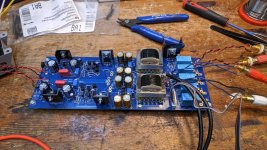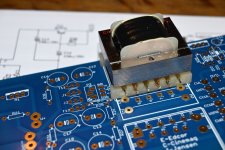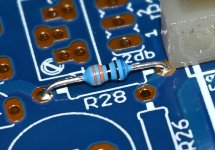^ Well, the good news is that you have so many options now... 🙂 AND It's one of the very last things you really need to do. So, there's plenty of time to figure out which way you want to go and get the parts you want.
Why I have dykes and a soldering station...SCSI
Why was this done on the Iron when Zen is still old skool?
Oh NOOOOO!I'm following Pa, he's Youngster, Hipster and Influencer
Starting soon with FW Podcast channel
Well, that was anticlimatic...yawn
Parts came in and Reima's Wurth socket fits the board and even the NKK ribbon.
Such troubles I caused! 🙄
I have a crap load of the 14 pin male header connector for mounting on the board. I think I ordered a pack of 28 and used 4 of them...offering them to anyone.
Another one lives.
I have some reading to do... I put heatsinks on the shunt MOSFETs as they were warm but not hot.... I thought when in a case it would be better to give them a bit of help. The relay MOSFET gets very hot without a heatsink so I put a bigger one on it (12v relays).
More reading now to be done for setting voltage (already nulled out the offset at the jumper). I'm using a 50k pot so will also follow the advice to raise the input resistor to 270k.
Fran
I have some reading to do... I put heatsinks on the shunt MOSFETs as they were warm but not hot.... I thought when in a case it would be better to give them a bit of help. The relay MOSFET gets very hot without a heatsink so I put a bigger one on it (12v relays).
More reading now to be done for setting voltage (already nulled out the offset at the jumper). I'm using a 50k pot so will also follow the advice to raise the input resistor to 270k.
Fran
Attachments
remove hsinks from all mosfets, use smaller one for relays PSU mos - that big one is too much, ugly, not Fugly!
no need for pads, anywhere
use some goop to increase transfer
re-check output offset, once you set rails to +/-15Vdc
no need for pads, anywhere
use some goop to increase transfer
re-check output offset, once you set rails to +/-15Vdc
OK, will do and will report back. relay mosfet was pretty hot without a heatsink.... too hot to touch, so by the Pass scale probably 65degC. Shunt mosfets just pretty warm, maybe mid 40s or so.
Good news is that it is dead quiet which is always a nice thing!
Good news is that it is dead quiet which is always a nice thing!
Good morning Zen Mod,
I am pretty sure there will be wonderful sounds coming out of this beautiful 'sound machine'... if the rest of the set up is as good
Enjoy the sound, woodturner - fran!



Cheers
Dirk
I am pretty sure there will be wonderful sounds coming out of this beautiful 'sound machine'... if the rest of the set up is as good
Enjoy the sound, woodturner - fran!




Cheers
Dirk
Good morning? MZM has sleepy hours now. One day, I will drive through Germany and Italy and pick up you and Peppennino. Then we can drive to RS and surprise him, and bring some coffee and SCSI cables, and Schlivo 
I also hear he is short on speaker drivers, we can bring some of those too. And maybe some Nordost fancy power cables, that he loves so much. Schlivo and Nordost, and good company. One needs nothing more

I also hear he is short on speaker drivers, we can bring some of those too. And maybe some Nordost fancy power cables, that he loves so much. Schlivo and Nordost, and good company. One needs nothing more

Short report....
DC nulled out easily with both rails at 15V.
Mosfets (M1/2) are at 35-40degC above ambient with no heatsinks. ZM - I'm guessing you like these at the warmer temp? Why? Maybe I missed this in the thread.
Relay mosfet is at 50degC with the heatsink. On reflection, using 24V relays and burning less current would have been a better choice but no biggie either way I think. I'll get a listen tonight in the main system and see how it sounds on a real test there.
DC nulled out easily with both rails at 15V.
Mosfets (M1/2) are at 35-40degC above ambient with no heatsinks. ZM - I'm guessing you like these at the warmer temp? Why? Maybe I missed this in the thread.
Relay mosfet is at 50degC with the heatsink. On reflection, using 24V relays and burning less current would have been a better choice but no biggie either way I think. I'll get a listen tonight in the main system and see how it sounds on a real test there.
MZM does not like those temps. I think he is suggesting you remove the pads from M1/2 and instead use only thermal goop between them and the sinks. For longevity wrt hest transfer. Using goop with Keratherm is not preferred, plus it is a mess.
Of course, it is possible you made a mistake somewhwere so that there is too mich I throught your MOSFETs. MZM will catch it if that is the case.
Of course, it is possible you made a mistake somewhwere so that there is too mich I throught your MOSFETs. MZM will catch it if that is the case.
Last edited:
no need for sinks on M1/2
M3 no sinks with 24Vrelays
must with 12V relays and less
no thermal pads needed if htsnk used, goop yup good
M3 no sinks with 24Vrelays
must with 12V relays and less
no thermal pads needed if htsnk used, goop yup good
That is soooo 2005. Onlyfans is more 2020.
Papa's Force is strong
he's having his personal OnlyFans site for , how long ... 20 or so years ?
guess where ........
just go for it
none of resistors is critical regarding dissipation
use smaller as you wish, just don't push bigger fancy drek .......... as some are doing ......... being hypnotized with exclusivity

I just initiated my build of the SE kit version using the miniature 330R for R28/R29. Then it is possible to mount the Cinemag without using a Dremel tool!
Cinemag just mounted for display. Will be the last component to be soldered in!
Will see what to solder next! .......maybe another resistor! ......or some diodes......got some 1N4004....
Attachments
- Home
- Amplifiers
- Pass Labs
- Iron Pre Essentials Kits For The DIYA Store - Register Your Interest



